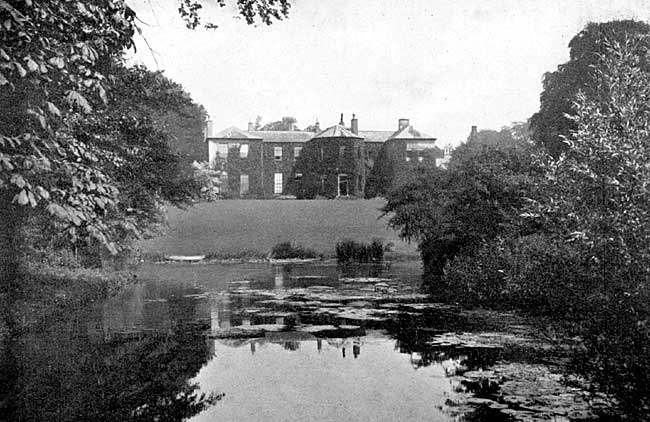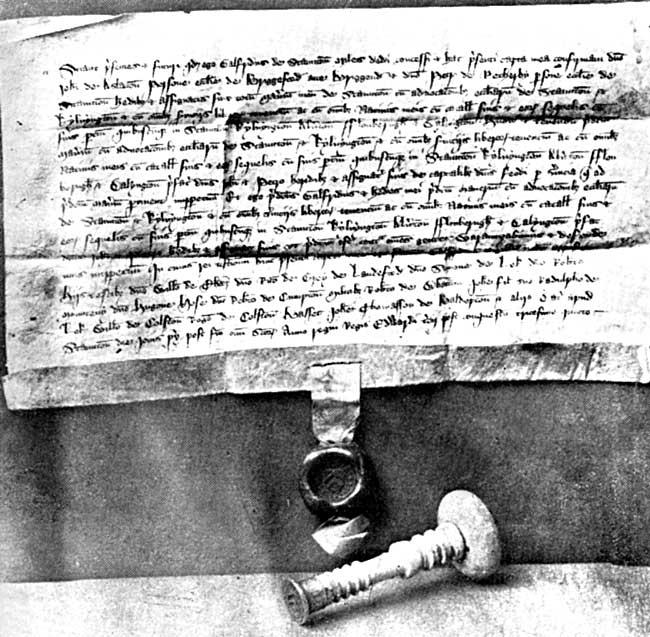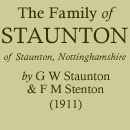
Staunton Hall, south front.
II.
The date of William de Staunton's death is not accurately known; he was certainly living in 1216, and was ultimately succeeded by his son Geoffrey, who can be traced in various dated records between the years 1239 and 1269. His wife was Alice, daughter of his overlord, Lord Ros of Hamlake. The most important documents to which he was a party are two agreements made in the years 1239 and 1257 respectively between him and the Priory of Haverholme, in Lincolnshire. This religious house had been founded by Alexander, Bishop of Lincoln, in 1139; and in some way not clearly known, had received lands in Staunton and Thoroton. The Staunton portion of the property lay in the part of the parish then as now called the Marre or Moor, and inevitable difficulties arose with respect to the extent of the common rights possessed by the men of the Priory in the lands and waters of Staunton. The agreements which have been referred to represent successive attempts at a settlement, but disputes continued until the time of the dissolution, when these lands were given by Henry VIII. to two members of the Tresham family, from whom they were purchased by Jerome Brand, of Staunton Grange, and finally incorporated in the Staunton estate in the reign of Elizabeth. But it is a remarkable fact that so late as the early eighteenth century an independent court was still held for the Haverholme property, known as the manor of Staunton Haverholme, twice yearly, on the same days as the court held for the manor of Staunton, with its members in Alverton, Kilvington, and Flawborough. Whatever its origin, the Haverholme estate was evidently created out of that portion of the village of Staunton which is entered in Domesday as a member of King William's manor of Orston.
Sir Geoffrey de Staunton in his will made John de Staunton an executor, and we find the following acquittance in Latin;—
"May it appear to all that we W. Brown, Sub-Dean of Wells, Commissary of the venerable man Hugh of Engelsoma, the Nuncio of our Lord the Pope in the Diocese of Bath and Wells, have received of John de Staunton executor of the will of Geoffrey de Staunton, deceased, eighteen marks of Sterlings in part of payment of twenty marks due from the legacy of the said deceased for the subsidy of the Holy Land which the same executor paid to us, and thence on divers particulars had our letters of Acquittance and them accidently (casualiter) lost as he says. Whence these letters of Acquittance at the requisition of the same we have made and with our seal certified in testimony of the Promises given at Wells the 4th of the Ides of January in the year of our Lord 1327."
This subsidy for the Holy Land was of such consequence that the Pope seems to have sent out Nuncios to different parts of the Kingdom who appointed the dignitaries of the Church their Commissaries for the purpose of collection. It is worth observing the dignity of the Church in 1327, when the Sub-Dean as Commissary of the Pope's Nuncio cannot give a receipt except in the plural number. By this Acquittance it appears that Geoffrey died before 1327, and that John paid the legacy in the Diocese of Bath and Wells in which he probably resided. It is his son of whom Cade speaks as a Devonshire knight.
There is also the following Deed Poll, given to John de Staunton three years later:—
"Know all by these presents that I John Asseballok of Newark have released remised and for ever quit claimed to Sir John de Stanton, kt, all manner of actions and complaints, petitions, and demands which I may be able to have against the said Sir John by reason of whatever contract or debt from the beginning of the World to the day of the making of these presents. In witness of which thing I have placed my seal to the present writing. Dated the Feast of St. Luke the Evangelist in the year of Grace 1330."
By the above two deeds it may be gathered that John de Staunton was knighted between the years 1327 and 1330. It should also be noted that the term "year of Grace" is used instead of the more usual form. The actions to which the deed refers were brought by Sir John de Staunton as attorney for Geoffrey de Staunton to recover the rents in Staythorpe and Silkby originally settled on Margaret de Staunton, and which after her death without issue apparently came into the hands of John Asseballok, who may have been a money lender.
Alice de Staunton, widow of Geoffrey de Staunton, was an executrix to her husband's will. Her daughter gives a receipt for a legacy from her father in the following words:
"To all the faithful of Christ who this writing shall see or hear Margaret daughter of the late Sir Geoffrey de Staunton greeting in the Lord, know ye that in my full power and virginity I have fully and entirely received all the money and chattels which Lady Alice de Staunton my mother in her custody had or ever owed me in the name of legacy of Sir Geoffrey de Staunton my father or of the Lady Christiana Amis or of any other legacy or debt or in any other manner. Of all which singular chattels and debts I acknowledge myself well and entirely to be satisfied and to the said Lady Alice my mother on all and singular these things my quit claim I do make for ever. In witness whereof I have set my seal to the said writing. These being witnesses Sir James Birun knt, William de Staunton my brother, Master Amis of Wingfield, Robert de Staunton in Scredington, Clerk, William de Graham in Bassingham, clerk."
Though this release is undated, it was probably executed between the 6th and 8th years of Edward I. Sir James Birun, the first of these witnesses, was Lord of the Manor of "Eadene," in Lincolnshire, and married a daughter of William de Ros, of Hamlake.
Margaret de Staunton appears to have been twice married, first to Roger de Thurleby, and secondly to Sir Theobald de Trykingham. On the second marriage her brother William de Staunton settled upon her and her husband and their issue, if any, certain rents in Staythorpe and Silkeby, "with the homages, reliefs, services, escheats of the free tenants." As Margaret died without issue of this marriage, these rents were afterwards claimed in an action by Geoffrey de Staunton, grandson of the said William.
The deeds relating to the various transactions of this Sir William de Staunton are somewhat faded, evidently from the action of damp, though still quite legible. In 1277 he was required by Robert de Ros of Belvoir, his over-lord, to accompany him to the war in Wales, and was granted a protection until Michaelmas while on this service, and two years later he went into France on military service. He was owner of large possessions in Lincolnshire and elsewhere, including the Manors of Bassingham and Quarrington. In a document dated 1305 it is stated five priests, "Bryan de Herdeby, Henry Youngman of Bassingham, Thomas FitzHugh of Old Sleaford, and William FitzWilliam, clerks in the Vigil of the Nativity of our Lord. 27 Edward I., at the manor of Querinton, with force and arms came and the cattle of William FitzJohn carried away and a chest there broke and the goods and chattels of the said William as well in the same chest as in the aforesaid manor found to the value of £30, these also carried away. And because the clergy ought not to be punished by the laity the parties were thereby cited to appear in the Cathedral Church of Lincoln, to proceed thereupon." In his will, dated 9th November, 1312, this William gave his body to be buried in the churchyard at Staunton, with which he bequeathed his palfrey with its furniture. A breast-plate dug up on the restoration of the church, and now hanging in St. Lawrence's choir, probably belonged to this stout knight. To William, his son, in his will he gave a ring with a sapphire and another with a seal of cornelian, likewise a murrey cup with a foot; to Isabel his own wife he gave a silver cup in which was a certain shield. After other like legacies, which included a cup of a nut to his grandson Geoffrey, he left to the friar Elias of Leasingham 6s. and 8d. for the first day of his sepulchre, and 10 marks for the 7th. He left also instructions that two foot-men should go on the first passage to the Holy Land in his name, and each have five marks.

Seal of Geoffrey de Staunton, 1362.
Sir William died in 1326, predeceased by his son William, mentioned in the above will. The estates therefore passed to Sir William's grandson, Geoffrey de Staunton, the third and last of that name, who held them until his death in 1370. In or about the year 1332, the latter bestowed on his second son, John, a house in Northgate, Newark, with an acre of ground, together with another piece of land in "Frere" lane and certain fields in Averham and Kelham. This John de Staunton proceeded to add to his property by purchasing a piece of garden ground from Emma, widow of Thomas de Holm; the deeds relating to these transactions have in most instances the seals still attached to them. In 1346, John was presented to the Rectory of Staunton, and in 1350 he re-conveyed to his father all his Newark property. In 1362 and 1370, Sir Geoffrey executed three deeds, in which he granted to John de Aslacton, parson of Briggeford atte Bridggend, and Master Peter de Rotherby, parson of Staunton, his manor of Staunton, two advowsons and "the services of his free tenants and all his natives with their chattels and issue." The seals on these three documents are in a perfect state of preservation. The ancient seal with which these impressions were made is of silver, on the band round the seal and joining it to the ivory stem is engraved the Staunton motto "En Dieu ma Fie." A reproduction of Sir Geoffrey's deed, with a picture of the interesting relic described above, is here given. This seal, which was frequently used by Robert Staunton, in Queen Elizabeth's reign, was left with the rest of the Staunton silver and furniture, by the Rev. Dr. Staunton to the family of his daughter, Mrs. George Gordon. A granddaughter of this lady generously restored it to the Stauntons, and it is now in the possession of the writer.
This Gefrey was a learned man,
And well scene in ye lawe,
Bothe grave modest and wise also
And once shrieve was I know;And in election once again
That office to have used,
Justice of peace he long time was,
Till life had him refused.
Apparently no more anxious to fill the office of sheriff than are the landowners of the present day, Sir Geoffrey wrote a letter to excuse himself on the occasion of his second appointment.
In 1325 Symon de Sibthorpe lord of that manor, obtained permission from Sir William de Ros of Belvoir to give certain lands in Staunton and Orston to found a chantry at Staunton. A building, called the chapel, existed until the beginning of the nineteenth century, having a separate service and separate registers for the parish church, though situated only about 80 yards away in the south corner of Staunton churchyard. The building was removed by the Rev. Dr. Staunton, and no traces of it can now be found. In the course of the centuries which succeeded its being built, the inhabitants of Orston objected bitterly to the charge it constituted upon their parish, and many documents relating to actions at law, sworn statements, and similar legal transactions on their part with a view of ridding themselves of this chapelry are to be found in the papers before us.
